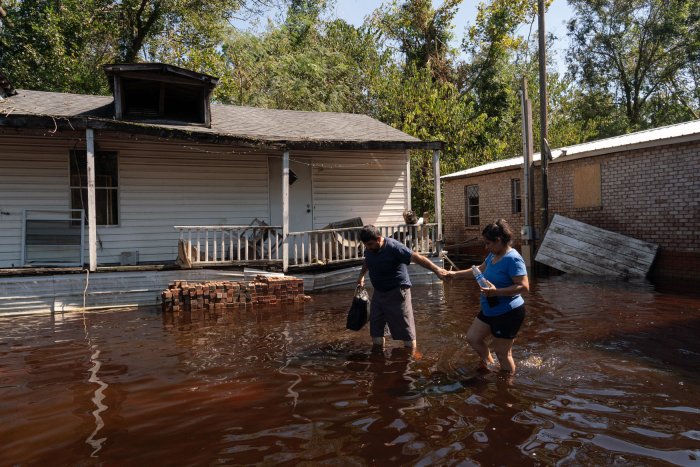<< Show Caption >>
Sept. 13 (UPI) -- More than 100,000 people were without power in North Carolina and some areas began to flood as Hurricane Florence began to reach the coastal United States.
As many as 134,596 homes and businesses were without power in North Carolina on Thursday night as the storm brought heavy wind to the state, The Weather Channel reported.
Earlier Duke Energy said it expects between 1 million and 3 million customers to be without electricity at the height of the storm.
"The magnitude of the storm is beyond what we have seen in years," Duke Energy incident commander Howard Fowler said in a statement. "With the storm expected to linger, power restoration work could take weeks instead of days.
"It's important for people to know this is no ordinary storm and customers could be without power for a very long time."
The utility said more than 20,000 workers were ready to restore power -- its largest mobilization in history.
Duke Energy added it could take up to several weeks to fully restore power in areas left inaccessible due to flooding brought on by the storm.
Roads in North Carolina's Craven County flooded Thursday afternoon as the Neuse River was inundated with rain and began to overflow, The Charlotte Observer reported.
Amber Parker, the county's human resources director, said the flooding had come later than expected, but the county was prepared for conditions to deteriorate.
As the Carolinas braced for the storm Thursday, roads and tourist shops were closed, regional flights were canceled and residents who didn't evacuate were working to protect their property against the severe weather ahead.
As if that weren't enough, an earthquake also hit South Carolina about 6:30 a.m. Thursday. The 2.6-magnitude quake was the state's fifth this year.
Florence was expected to move onto the Carolina shore early Friday as a Category 2 storm, bringing "catastrophic" rainfall and flash floods.
Most of the coastal region's airports closed Thursday, with no flights expected until at least Saturday. That included the busy Charleston and Myrtle Beach airports in South Carolina and Wilmington in North Carolina. At least 1,400 flights were canceled by Thursday morning.
The hundreds of cancellations at Charlotte's airport, a major hub for American Airlines, were largely by regional affiliates that fly between Charlotte and smaller airports along the coast. Southwest Airlines canceled its Charlotte schedule on Thursday, effective through "early morning Saturday."
Vehicular bridges to North Carolina's Bogue Banks closed on Thursday, with no one allowed onto the beaches and shores until further notice.
Along the waterfront in Myrtle Beach, S.C., a city dependent on tourism, stores and restaurants were boarded up, with some protective plywood spray-painted with quotes of encouragement. Some recreational boats remained in the water.
Restaurant owner Serina Taylor told Myrtle Beach Online, "It's very frightening. It's going to be a devastating time for many, many people up and down the coast," as she removed items from an office and moved boats into a cove.
Rain was falling on the coast Thursday morning from the clouds on the farthest edges of the hurricane. Among those feeling the impact of the storm were local farmers, whose tobacco and corn harvests had not been completed. Additional crops, including all of North Carolina's cotton, remain to be harvested.
"We may have 60 percent of the tobacco harvested in North Carolina. Corn harvest ranges 75 percent in the east to just beginning in the west," said Steve Troxler, the state's agricultural commissioner. "Unfortunately, sweet potatoes and peanuts are just getting underway with harvests, and I'll remind you that we're number one in the nation in sweet potatoes. Soybeans have just begun harvesting in the very far eastern part of North Carolina but have not begun anywhere else in the state."
North Carolina activated 2,800 National Guard personnel, and South Carolina called up 2,100 of its National Guard soldiers to be ready to aid in recovery efforts once the storm has passed.
Government disaster management agencies have encouraged evacuation.
"We are on the wrong side of this storm, where most of the damage is done," North Carolina Gov. Roy Cooper said Wednesday. "Plan to be without power for days. Check on your family and neighbors to make sure they are prepared as well. The storm surge alone is likely to flood tens of thousands of structures. At least 50 shelters are open now across the state."
South Carolina Gov. Henry McMaster ordered the closure of schools in 18 counties earlier in the week. Area colleges canceled classes but most will keep food service and health centers open, and some ordered evacuations from dormitories. Most city and county offices in coastal South Carolina were closed by Wednesday, with emergency services still in place. Athletic events, notably college football games, also were postponed.
Catastrophic rainfall is expected to accompany the hurricane's 110 mph winds. Charleston, S.C., could see more water than it did during last year's Tropical Storm Irma if the hurricane stalls as it hits land and pushes additional water onto the coast. Charleston felt the impact of three days of record-setting 10-foot storm surges in 2017. A high tide could push 1 feet to 3 feet of water on shore, the National Hurricane Center said.















